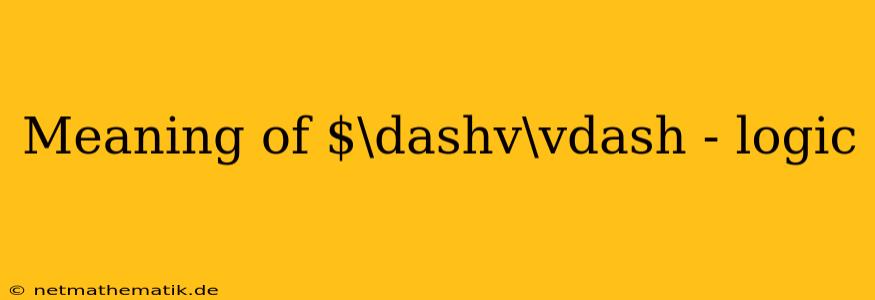The concept of $\dashv\vdash$ is a fundamental element in logic, particularly within the realm of formal systems and proof theory. It signifies a powerful relationship between two statements or formulas, indicating their logical equivalence or inter-derivability. This equivalence is not merely a matter of semantic truth but a consequence of the deductive rules governing the logical system in question. This article delves into the intricate meaning of $\dashv\vdash$, unraveling its significance and illuminating its applications in various logical contexts.
The Essence of $\dashv\vdash$
At its core, $\dashv\vdash$ represents a "mutual entailment" or "inter-derivability" relationship between two statements or formulas. This means that each statement can be formally derived from the other within a specific logical system. The symbol is essentially a shorthand for expressing this bidirectional implication:
A $\dashv\vdash$ B is equivalent to saying A $\Rightarrow$ B and B $\Rightarrow$ A, where "$\Rightarrow${content}quot; represents logical implication.
Understanding $\dashv\vdash$ in Formal Systems
To grasp the meaning of $\dashv\vdash$ fully, we need to consider its context within a formal system:
-
Formal System: A formal system comprises a set of axioms (fundamental truths) and inference rules (logical steps that allow us to derive new truths from existing ones).
-
Deduction: Within a formal system, a deduction or proof is a sequence of statements, each of which is either an axiom or derived from previous statements using inference rules.
-
Theorem: A theorem is a statement that can be proven within a formal system.
With these concepts in mind, A $\dashv\vdash$ B implies that:
-
A can be derived from B: There exists a deduction within the formal system starting from B and ending with A.
-
B can be derived from A: There exists a deduction within the formal system starting from A and ending with B.
This bidirectional derivability highlights the fundamental connection between A and B within the framework of the chosen formal system.
Examples of $\dashv\vdash$ in Action
Let's illustrate the use of $\dashv\vdash$ with some examples:
1. Propositional Logic:
In propositional logic, the symbol $\dashv\vdash$ is used to express logical equivalence between propositions. For example:
-
p $\land$ q $\dashv\vdash$ q $\land$ p: The conjunction of p and q is logically equivalent to the conjunction of q and p (commutativity of conjunction).
-
p $\Rightarrow$ q $\dashv\vdash$ ¬p $\lor$ q: The implication "if p then q" is logically equivalent to the disjunction "not p or q" (material implication).
2. First-Order Logic:
In first-order logic, $\dashv\vdash$ is used to show the logical equivalence between formulas within a given theory. A theory is a set of axioms and inference rules specific to a particular domain of discourse. For example:
- ∀x (P(x) $\Rightarrow$ Q(x)) $\dashv\vdash$ ¬∃x (P(x) $\land$ ¬Q(x)): The universal quantification of "if P(x) then Q(x)" is equivalent to the negation of the existential quantification of "P(x) and not Q(x)".
3. Set Theory:
Within set theory, $\dashv\vdash$ can be used to demonstrate equivalence between set-theoretic statements. For example:
- A $\subseteq$ B $\dashv\vdash$ ∀x (x ∈ A $\Rightarrow$ x ∈ B): The statement "A is a subset of B" is equivalent to "for all x, if x is an element of A then x is an element of B".
Importance of $\dashv\vdash$ in Logic
The concept of $\dashv\vdash$ plays a crucial role in various aspects of logic:
-
Proof Theory: $\dashv\vdash$ is fundamental in proof theory, allowing us to determine when two statements are equivalent within a formal system.
-
Model Theory: In model theory, $\dashv\vdash$ is used to establish connections between logical formulas and their interpretations in structures.
-
Logic Programming: The concept of $\dashv\vdash$ is vital in logic programming, where it is used to define the semantics of logic programs and to reason about their behavior.
-
Formal Verification: In formal verification, $\dashv\vdash$ is used to prove the correctness of software and hardware systems.
Further Exploration
The meaning of $\dashv\vdash$ is closely tied to the notion of completeness in formal systems. A formal system is complete if every true statement within the system can be proven as a theorem. Completeness theorems play a crucial role in logic, ensuring that our systems are powerful enough to capture all the truths within their domain.
Furthermore, the concept of $\dashv\vdash$ is intimately related to the concept of soundness. A formal system is sound if every theorem in the system is also a true statement. Soundness guarantees that our deductions are valid and lead to genuine truths.
Conclusion
The symbol $\dashv\vdash$ represents a profound concept in logic, signifying the inter-derivability or logical equivalence of statements within a formal system. Its importance extends across diverse areas of logic, influencing proof theory, model theory, logic programming, and formal verification. Understanding the meaning of $\dashv\vdash$ is essential for comprehending the foundations of logic and its applications in various fields. It provides a powerful tool for expressing and analyzing the logical relationships between statements, enabling us to reason effectively about the world around us.
